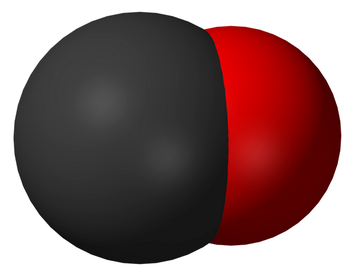Carbon monoxide

Carbon monoxide, or CO, is a gas that forms from the incomplete combustion of fuels such as propane, natural gas, gasoline, oil, coal, or wood. It is a colourless, odourless, and tasteless gas, so it cannot be detected without a specialized piece of equipment.[2] Exposure to carbon monoxide can cause serious health problems.
There are many sources of carbon monoxide that exist, including furnaces, gas water heaters, wood stoves, and other fuel-burning appliances. If these devices are not used properly or malfunction, it is possible for them to release carbon monoxide. Along with these major sources, blocked chimneys, car exhaust, and tobacco smoke are all additional sources of carbon monoxide.[2] Carbon monoxide can also enter the atmosphere from the natural environment. CO is released by erupting volcanoes, by forest fires, and from marsh gases and marine algae.[3]
Industry is also a major contributor to carbon monoxide emissions. Significant amounts of carbon monoxide are released in metal manufacturing, ore and coal mining, electricity generation, food manufacturing, chemical production, petroleum refining, and concrete manufacturing.[3]
Environmental Effects
On a global scale, carbon monoxide does not have a significant environmental effect. However, near the site of emission, carbon monoxide can react with other air pollutants. When this reaction occurs, there is the potential for harmful ground level ozone to be formed.[4]
One of the more significant effects carbon monoxide has is its effect on living organisms. Because of the way carbon monoxide reduces the body's ability to transport oxygen, exposure to it is harmful. There have been recent attempts made to reduce the amount of carbon monoxide that is released into the atmosphere by improving industrial furnace operation and encouraging reduction through restrictions. These measures have resulted in carbon monoxide emissions decreasing over recent years.[5]
Health Effects

Carbon monoxide is extremely dangerous to human health if inhaled. It reduces the body's ability to carry oxygen in the blood.[2] Depending on levels of exposure, the health effects of carbon monoxide can differ. At low levels of exposure carbon monoxide may cause headaches, fatigue, shortness of breath, or impaired motor functions (which could result in difficulty walking).[2] At high levels or long exposure time, carbon monoxide can cause dizziness, chest pain, blurred vision, and difficulty thinking.[2] Finally, at very high levels exposure to carbon monoxide can result in convulsions, coma, or even death.[2]
Although carbon monoxide is harmful, it is easy to reduce the risk of carbon monoxide exposure in the home. First, carbon monoxide detectors can be installed to warn homeowners about harmful CO levels. These detectors should be placed in hallways outside bedrooms so that they can be heard at night when people sleep. If the alarm sounds, it is important to leave the home right away. Maintenance of fuel-burning appliances reduces the risk that carbon monoxide will enter the home. Ensure that furnaces, fireplaces, and gas stoves are well maintained. Outdoor, fuel consuming equipment should never be used inside. Appliances like barbecues, fuel-burning camping equipment, or power generators should not be used in the home, garage, vehicle, camper, or tent. Finally, do not let vehicles idle inside of the garage even if the door is open.[2]
Interactive Graph
Below is an interactive graph showing where carbon monoxide emissions come from in Canada. Note that significant amounts of carbon monoxide are produced in industry or from transport sources, mainly vehicles. For a more in-depth look at pollution data, including a graph showing how carbon monoxide emissions have changed over time, click here.
For Further Reading
- Combustion
- Fuel
- Greenhouse gas
- Ozone
- Pollutant
- Or explore a random page
References
- ↑ Wikimedia Commons. (July 20, 2015). Carbon Monoxide 3D Model [Online]. Available: https://upload.wikimedia.org/wikipedia/commons/a/a7/Carbon-monoxide-3D-vdW.png
- ↑ 2.0 2.1 2.2 2.3 2.4 2.5 2.6 Health Canada. (July 20, 2015). Carbon Monoxide [Online]. Available: http://www.hc-sc.gc.ca/ewh-semt/air/in/poll/combustion/carbon-eng.php
- ↑ 3.0 3.1 NPI. (July 20, 2015). Carbon Monoxide [Online]. Available: http://www.npi.gov.au/system/files/resources/02ecfe23-3a97-0a34-b9a4-82b06f7a09fa/files/factsheet-carbonmonoxide.pdf
- ↑ SEPA (July 20, 2015). Pollutant Fact Sheet: Carbon Monoxide [Online]. Available: http://apps.sepa.org.uk/spripa/Pages/SubstanceInformation.aspx?pid=4
- ↑ US EPA. (July 20, 2015). Air Trends [Online]. Available: http://www.epa.gov/airtrends/aqtrnd95/co.html
- ↑ Wikimedia Commons. (July 20, 2015). Detektor CO [Online]. Available: https://commons.wikimedia.org/wiki/File:Detektor_CO.jpg#/media/File:Detektor_CO.jpg

